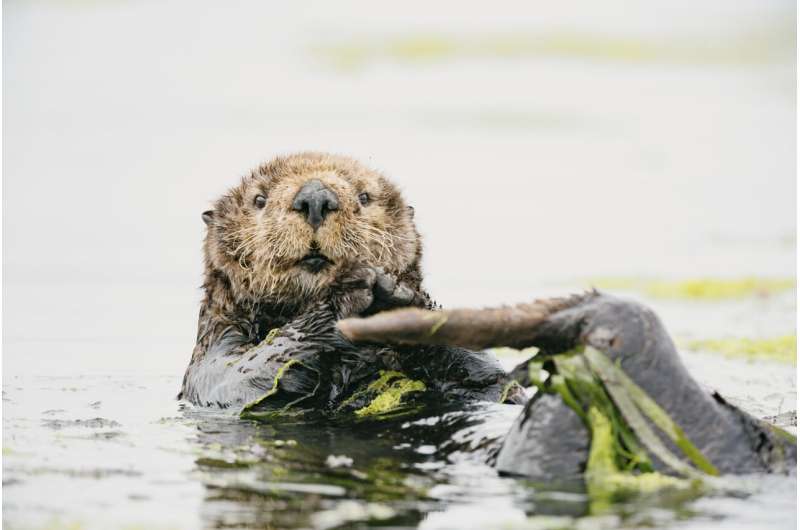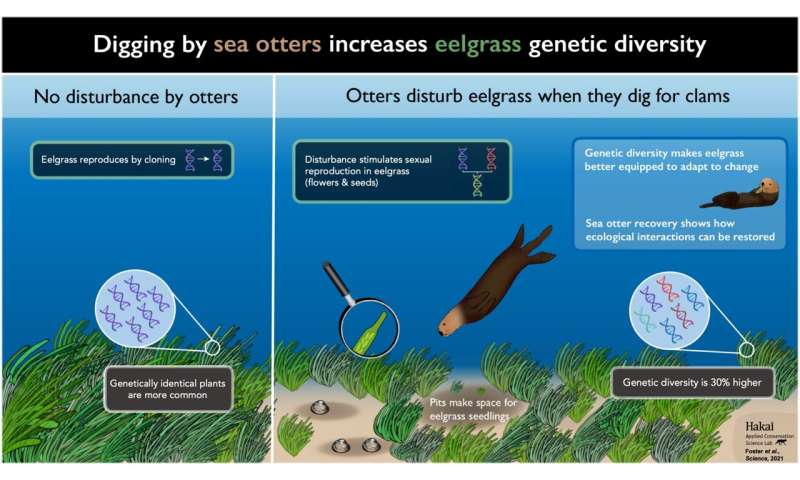
Sea otter resting in eelgrass with eelgrass draped over its hind foot.
Credit: Kiliii Yüyan Photography
A team of researchers affiliated with a host of institutions in Canada and one in the U.S. has found that eelgrass genetic diversity increases when sea otters live in eelgrass meadows. In their paper published in the journal Science, the group describes their study of eelgrass meadows under different conditions. Joe Roman, with the University of Vermont, has published a Perspectives piece in the same journal issue outlining the work by the researchers in this new effort.
Prior to the arrival of Europeans, the shores off the western coast of North America were filled with sea otters. Sadly, hunters drove them to near extinction over the ensuing century. In this new effort, the researchers have looked at the impact that sea otters have on eelgrass meadows when they are reintroduced by environmentalists.
Eelgrass meadows grow near the shore from the bottom of the sea to the surface. Such meadows, like coral reefs, are home to a large number of sea creatures, some of which serve as prey for sea otters. Clams, the researchers note, are especially enjoyed by the otters. The otters swim down to the seafloor, feel them out using their whiskers, then dig them up, crack them open and eat them. Prior research has shown that this activity leads to divots or bare patches on the seafloor. The researchers took a closer look at the impact of clam digging by sea otters on eelgrass meadows. Their work involved collecting large numbers of samples of the grass from multiple meadows, some of which were inhabited by sea otters and some that were not. They also noted some samples were collected from meadows where seas otters had been recently reintroduced and some were from meadows where the otters had been living for decades.
A team of researchers affiliated with a host of institutions in Canada and one in the U.S. has found that eelgrass genetic diversity increases when sea otters live in eelgrass meadows. In their paper published in the journal Science, the group describes their study of eelgrass meadows under different conditions. Joe Roman, with the University of Vermont, has published a Perspectives piece in the same journal issue outlining the work by the researchers in this new effort.
Prior to the arrival of Europeans, the shores off the western coast of North America were filled with sea otters. Sadly, hunters drove them to near extinction over the ensuing century. In this new effort, the researchers have looked at the impact that sea otters have on eelgrass meadows when they are reintroduced by environmentalists.
Eelgrass meadows grow near the shore from the bottom of the sea to the surface. Such meadows, like coral reefs, are home to a large number of sea creatures, some of which serve as prey for sea otters. Clams, the researchers note, are especially enjoyed by the otters. The otters swim down to the seafloor, feel them out using their whiskers, then dig them up, crack them open and eat them. Prior research has shown that this activity leads to divots or bare patches on the seafloor. The researchers took a closer look at the impact of clam digging by sea otters on eelgrass meadows. Their work involved collecting large numbers of samples of the grass from multiple meadows, some of which were inhabited by sea otters and some that were not. They also noted some samples were collected from meadows where seas otters had been recently reintroduced and some were from meadows where the otters had been living for decades.
Eelgrass meadow on Calvert Island when otters were just beginning to return - otter pits are visible at the meadow-edge but later occurred within the meadow.
Credit: Grant Callegari, Hakai Institute.
The researchers conducted a genetic analysis of the grass samples and then compared them. In so doing, they found that eelgrass meadows with otters were more genetically diverse. They also found that the longer the sea otters lived in a meadows, the more diverse the grass became. They suggest that physical disturbances by predators can lead to increased diversity and more resilience in the face of changing environments.


Sea otter digging enhances eelgrass genetic diversity which can build resilience to environmental change.
Credit: Josh Silberg and Erin Foster
Erin snorkeling in an eelgrass meadow, to examine if seedlings are attached to parent plants (clones) or if rhizomes are free (result of seed germination). Credit: Carly Janusson, Hakai Institute
Sea otter digging enhances eelgrass genetic diversity which can build resilience to environmental change. Credit: Josh Silberg and Erin Foster
Erin snorkeling in an eelgrass meadow, to examine if seedlings are attached to parent plants (clones) or if rhizomes are free (result of seed germination). Credit: Carly Janusson, Hakai Institute
Erin snorkeling in an eelgrass meadow, to examine if seedlings are attached to parent plants (clones) or if rhizomes are free (result of seed germination). Credit: Carly Janusson, Hakai Institute
Sea otter digging enhances eelgrass genetic diversity which can build resilience to environmental change. Credit: Josh Silberg and Erin Foster
Erin snorkeling in an eelgrass meadow, to examine if seedlings are attached to parent plants (clones) or if rhizomes are free (result of seed germination). Credit: Carly Janusson, Hakai Institute
More information: Erin Foster et al, Physical disturbance by recovering sea otter populations increases eelgrass genetic diversity, Science (2021). DOI: 10.1126/science.abf2343
Joe Roman, The benefits of disturbance, Science (2021). DOI: 10.1126/science.abm2257
Journal information: Science
© 2021 Science X Network

No comments:
Post a Comment